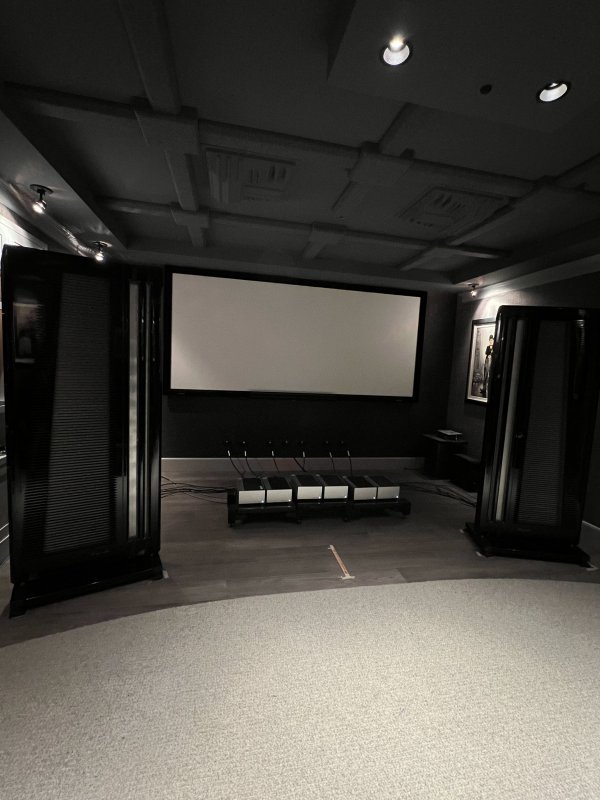I visited my friend Cyrus in Spokane, Washington, earlier in the winter to hear his system with Clarisys Auditorium loudspeakers. At that point, I had not yet set up my Clarisys Studio Plus speakers in my listening room for Audio Café. As most of you know, I represent Clarisys Audio as their Los Angeles dealer. Hence, visiting Cyrus was the first time I would hear Clarisys loudspeakers in a home environment.
After my visit to Cyrus, Roy Gregory followed up his review of the Clarisys Auditorium loudspeakers with an extensive report on his use of six channels of amplification using an active crossover to drive the Auditoriums. See https://gy8.eu/review/brilliant-adventure/
Cyrus was excited about the sonic possibilities reported by Roy Gregory from driving each driver in the Auditoriums with its dedicated amplifier: six loudspeaker drivers and six compact monaural amplifiers.
After Cyrus had discussed Roy's report with me, I suggested that Cyrus replicate Roy's configuration with six WestminsterLab REIs. I put Cyrus in contact with Gary Leeds of Hear This, the North American distributor for WestminsterLab. As to why I recommended REIs please see Post #400 of this thread: https://www.whatsbestforum.com/threads/re-imagining-class-a-amplification.34468/page-20
So Gary, representing Hear This, Angus Leung, representing WestminsterLab, and I, representing Clarisys Audio through Audio Café, decided we would form a team to collaborate on installing this unique system. I believe it is the first (after Roy) tri-amplified system using an active crossover on Clarisys loudspeakers in a home environment anywhere in the world
Thank you to Mike Bovaird of Suncoast Audio, the U.S. importer for Clarisys, for supplying us with the CS Port electronic crossover, and to Clarisys Audio head honcho Florián for his advice and excellent technical support!
As an tube purist active solid-state crossovers have been philosophically anathema to me. But I do always say that implementation trumps theory.
In this tri-amplified system with the CS Port ACN400 I heard greater weight and tonal density and natural warmth than I have heard before in Cyrus' system. I honestly don't know why the tonal balance changed so much in the sonic direction I personally prefer with all of the WestminsterLab components. Angus says that his transistor circuit design controls the loudspeaker driver in a way that reduces distortion.
On Jeff Buckley's "Hallelujah" the "twang" at the beginning of the song on Cyrus' system was a rich, golden, burnished sound I like, not the sharp, silvery, whitish sound I usually hear from that twang.
Was this the WestminsterLab components? The active crossover? The monaural amplifier dedicated to each individual driver? I don't know. I have to consider it the combination of all of the above.
There definitely is something sonically material to powering each loudspeaker driver with its own amplifier. And I have to say the ability to tweak frequency bands with the active crossover to one's ears' perfection was pretty seductive.
I concur with Roy Gregory's findings on the sonic efficacy of powering each loudspeaker driver with its own amplifier.

After my visit to Cyrus, Roy Gregory followed up his review of the Clarisys Auditorium loudspeakers with an extensive report on his use of six channels of amplification using an active crossover to drive the Auditoriums. See https://gy8.eu/review/brilliant-adventure/
Cyrus was excited about the sonic possibilities reported by Roy Gregory from driving each driver in the Auditoriums with its dedicated amplifier: six loudspeaker drivers and six compact monaural amplifiers.
After Cyrus had discussed Roy's report with me, I suggested that Cyrus replicate Roy's configuration with six WestminsterLab REIs. I put Cyrus in contact with Gary Leeds of Hear This, the North American distributor for WestminsterLab. As to why I recommended REIs please see Post #400 of this thread: https://www.whatsbestforum.com/threads/re-imagining-class-a-amplification.34468/page-20
So Gary, representing Hear This, Angus Leung, representing WestminsterLab, and I, representing Clarisys Audio through Audio Café, decided we would form a team to collaborate on installing this unique system. I believe it is the first (after Roy) tri-amplified system using an active crossover on Clarisys loudspeakers in a home environment anywhere in the world
Thank you to Mike Bovaird of Suncoast Audio, the U.S. importer for Clarisys, for supplying us with the CS Port electronic crossover, and to Clarisys Audio head honcho Florián for his advice and excellent technical support!
As an tube purist active solid-state crossovers have been philosophically anathema to me. But I do always say that implementation trumps theory.
In this tri-amplified system with the CS Port ACN400 I heard greater weight and tonal density and natural warmth than I have heard before in Cyrus' system. I honestly don't know why the tonal balance changed so much in the sonic direction I personally prefer with all of the WestminsterLab components. Angus says that his transistor circuit design controls the loudspeaker driver in a way that reduces distortion.
On Jeff Buckley's "Hallelujah" the "twang" at the beginning of the song on Cyrus' system was a rich, golden, burnished sound I like, not the sharp, silvery, whitish sound I usually hear from that twang.
Was this the WestminsterLab components? The active crossover? The monaural amplifier dedicated to each individual driver? I don't know. I have to consider it the combination of all of the above.
There definitely is something sonically material to powering each loudspeaker driver with its own amplifier. And I have to say the ability to tweak frequency bands with the active crossover to one's ears' perfection was pretty seductive.
I concur with Roy Gregory's findings on the sonic efficacy of powering each loudspeaker driver with its own amplifier.


